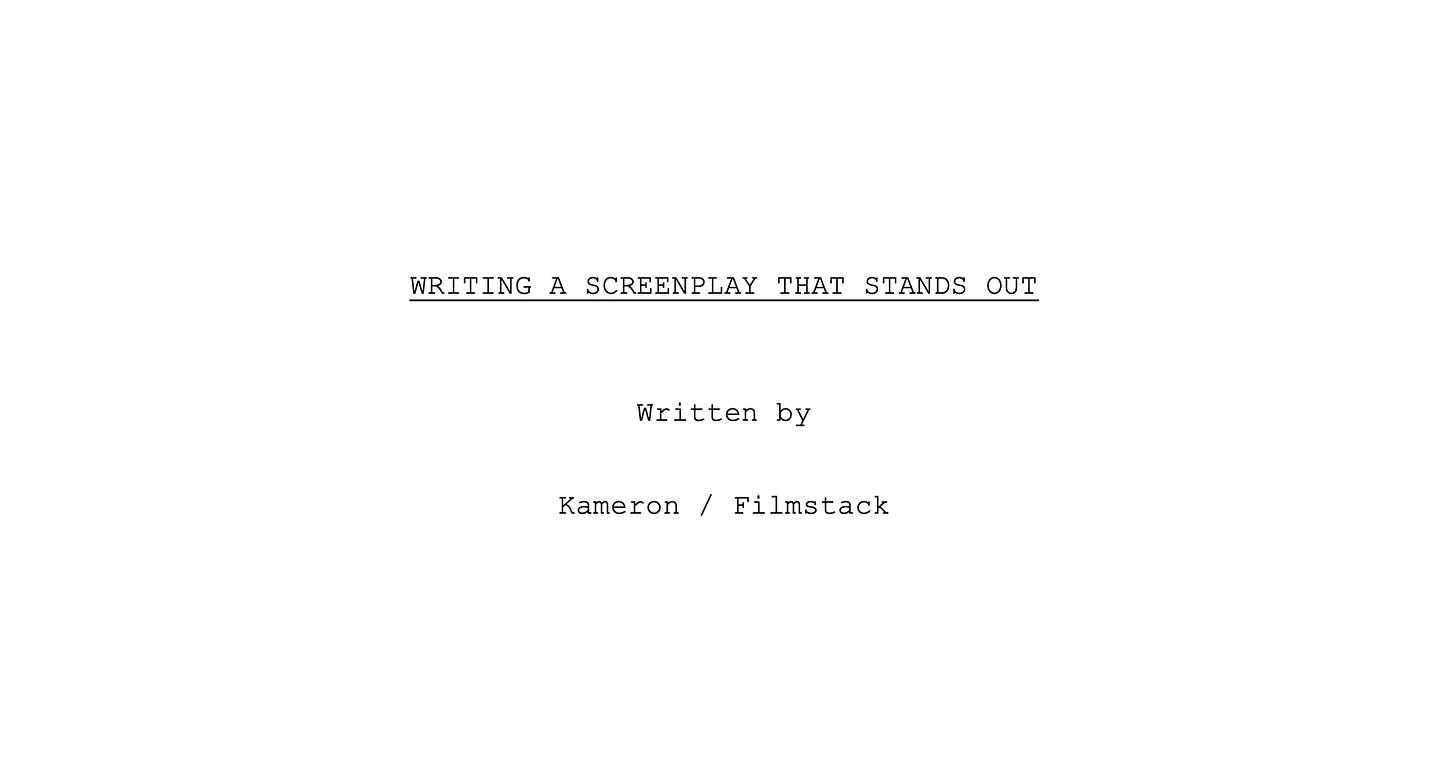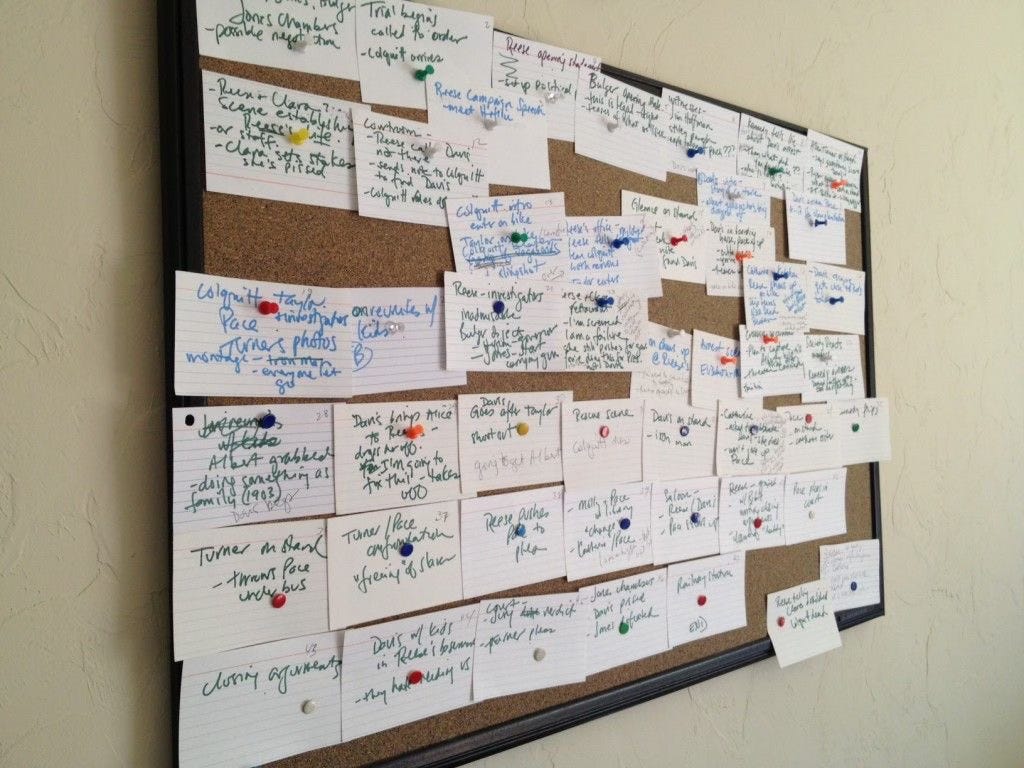Writing a Screenplay That Stands Out
Crafting a script that grabs attention - and keeps it.
So, you’ve got an idea for a film. You know you have a story worth telling. But now you need to make sure your script doesn't gather dust in the slush pile that is your creative backlog. Every screenwriter has the same dream: to write something so unique, so irresistible that readers can't put it down. So how do you do that?
Let’s try and break it down.
Forget the “Perfect Opening”, Start With Action.
The worst thing a new screenwriter can do is get bogged down by “perfectionism.” Sure, opening with a slow, emotional scene could be effective. But in the world of film, where attention spans are about as short as your Netflix watch history, your opening needs to do something. And fast.
Start with an action. A question. A moment of tension. Anything that grabs attention before the reader even has time to take a sip of their coffee.
Here’s a great example: Jaws doesn’t start with a peaceful beach scene; it starts with a girl getting attacked by a shark in the dark of the night. You don’t need to bite anyone in half—but you get the point. Get in there and go for it.
Show, Don’t Tell - But Don’t Overdo It.
What is that famous line?
Less is more. Annoying, but true.
Look, we all know the golden rule of screenwriting: Show, don’t tell. But here's the secret most newbies miss—don’t take it to the extreme. Show enough to make the audience feel the emotion, but don’t go overboard.
A great example: Pulp Fiction. The dialogue between Jules and Vincent in the diner is loaded with subtext. We get so much information about these characters' personalities, their world, and their relationship without a single big “reveal.” It’s masterclass storytelling disguised as casual chit-chat.
Characters Are King (or Queen) – Make ‘Em Stand Out
You can have the most brilliant plot, but if your characters don’t pop off the page, your script will fall flat. Ever wonder why we remember Tony Stark more than we remember the plot of Iron Man? That’sbecause it’s Robert Downey Jr., but it's also the way Stark was written. He was unpredictable, funny, flawed—and we cared.
Here’s a secret: Give your characters a flaw - it doesn’t need to be a big one, but something that creates conflict in them. A nice, tidy hero is boring. Give them a reason to be messy. Make them face internal struggles, even if the external ones are bigger. We love the messy characters. Just watch Killing Eve. Villanelle will show you what I mean with this.
Use Subtext Like a Pro.
Ever noticed how much people don’t say in movies? It’s all about what’s left unsaid. And that’s what makes screenwriting so powerful. Characters are almost always thinking something they aren’t vocalizing. The secret? Subtext.
Here’s a juicy example: The Social Network. The underlying tension between Zuckerberg and his friend Eduardo is never fully expressed directly, but it's always there, creeping into every conversation. It’s what makes the movie crackle with suspense—subtext is what makes the audience lean in.
Don’t tell your audience everything. Let them do some work.
Don't Let the Genre Confine You.
Sure, there are tons of genres out there, but the ‘best’ screenplays play with and twist these conventions. Your rom-com doesn’t have to be cookie-cutter. Your action film doesn’t need to be predictable. Instead, bend the genre and make it your own.
Take Get Out, for example. I love that film for so many different reasons. But in relevance, Jordan Peele didn’t just make a horror movie about racism; he made a commentary on society, expectations, and fears. It’s a social thriller wrapped in a genre package. And it worked.
‘Three Act’ Structure: Yes, It’s a Guide, Not a Rule
Okay, so here’s where things get a little controversial. The three-act structure is the standard. The setup, the confrontation, the resolution. Blah blah, right? But sometimes, the best films break the mold.
Take Memento, for example. This movie flips the three-act structure completely and still delivers a perfectly crafted story. Non-linear narratives can work—but don’t do it just to be different. There has to be a *reason* behind it.
Pacing Is Everything - Don’t Let Your Script Drag
Nobody likes a slow burn… unless it’s in a good way. A script should never feel like it’s dragging its feet. If your characters are sitting around talking for 20 pages about nothing, you’re losing your reader.
A great way to manage pacing? Break your scenes into smaller, more focused beats. Your scene should always be driving towards something, even if it’s a small revelation or change. Don’t let the tension drop. Gravity’s script is a great example—it keeps you on the edge of your seat by constantly moving forward.
Writing Is Rewriting: Never Settle
You’ve written your first draft. Great! You’re a writer. Now comes the real work: rewriting. The biggest mistake new writers make is thinking that a first draft is “the one.” It’s not.
In the world of film, the script is a living, breathing thing. It’s going to change a thousand times. Embrace it. Rewrite the dialogue, change the structure, kill your darlings—whatever it takes.
Take The Godfather. Coppola rewrote that script so many times, it’s like a whole different movie by the end. But that’s why it’s great.
Quick Tips for Breaking In:
Read.
The best writers read scripts. Read as much as you can, especially award-winning ones. Studying these will show you how a script is supposed to feel. If you’re serious about it, try The Black List (the list of top unproduced scripts in Hollywood). [Check it out here](https://www.blcklst.com/).
Write Every Day.
If you’re not writing every day, you’re just not doing it. I get it. Life happens. But if you want to be a screenwriter, treat it like a job—even if you're not getting paid yet. And for the love of all things holy, avoid the “I’ll wait for inspiration” trap.
Get Feedback.
Don’t just write in a vacuum. Find people to read your work. Join online writing communities or take part in script coverage services. But don’t be afraid to hear criticism. Every great writer got there through feedback.
Final Thoughts:
Screenwriting is like dating: If you’re just showing up and doing the bare minimum, it’s never going to work. You need to put in the effort. Be creative. Be bold. Take risks.
And don’t worry about making a “perfect” script. Just make one that feels ‘authentic’ - something that resonates with your voice.
Good luck! You got this.
Further Reading & Resources:
“Save the Cat! Writes a Movie” by Blake Snyder –
Why read: This book helps demystify story structure and gives you a reliable formula to ensure your script has a strong, compelling flow. If you're struggling to keep your plot focused and engaging, it’s a game changer.(https://www.amazon.com/Save-Cat-Writes-Movie-Expanded/dp/1932907009)
ScreenCraft –
Why read: ScreenCraft provides a wealth of articles and resources from industry professionals, breaking down the screenwriting process from the inside. It’s a great place for learning not only how to write, but how to get noticed in the competitive world of screenwriting. (https://www.screencraft.org/)
MasterClass: Aaron Sorkin Teaches Screenwriting
Why read: Aaron Sorkin’s approach focuses heavily on dialogue and pacing, teaching you how to use words to drive tension and drama. His class dives into how to create conflict and rhythm in your scenes, making your script’s dialogue stand out in the best way. (https://www.masterclass.com/classes/aaron-sorkin-teaches-screenwriting)
The Screenwriting Life Podcast
Why listen: Listening to working screenwriters talk about their craft is like getting a behind-the-scenes look at the realities of the industry. The podcast is full of insights on overcoming common writing struggles, while also providing encouragement to keep writing through difficult moments. (https://www.screenwritinglife.com/)
John Truby’s “The Anatomy of Story”
Why read: Truby goes deep into the psychology of storytelling, pushing you to think about how characters evolve over the course of your plot. His techniques will help you create multi-layered stories with emotional resonance, which is key to keeping your audience hooked. (https://www.amazon.com/Anatomy-Story-27-Right-Structure/dp/0865479938)
“Story” by Robert McKee
Why read: McKee’s book dives into the nuts and bolts of crafting a story that feels both epic and personal. His focus on universal storytelling principles will teach you how to build arcs that feel meaningful, making your script resonate with any audience. (https://www.amazon.com/Story-Substance-Structure-Screenwriting/dp/0413715606)
Happy to help. Make sure to subscribe! Please share, like, and comment. Looking forward to what everyone thinks of the Filmstack Newsletter. If you have any feedback or think I’ve missed something, I’d be happy to edit and add it in.
Until next time, and make sure to live in the moment - one frame at a time.






